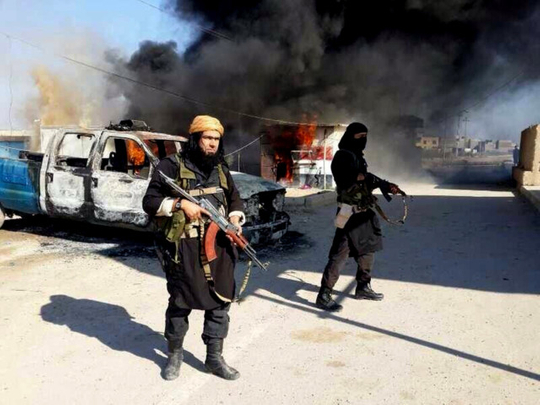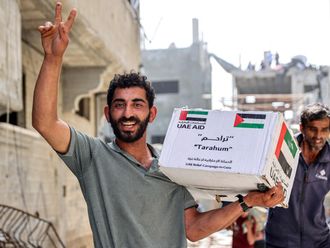
Cairo: Iraq’s Shiite-dominated government, which once aired testimony of alleged Al Qaida militants admitting being trained in Syria, now sides with Bashar Al Assad against a Sunni rebellion that includes a terror group trying to carve out its own statelet.
Meanwhile, Iraq’s Sunni opposition, which until 2010 sought refuge and support from a Damascus regime it staunchly defended, now provides political cover, and even manpower, to the rebellion against Al Assad.
The conflict in neighbouring Syria has twisted alliances and put immense pressure on Iraqi leaders trying to hold the country together as they assemble a government after April elections. Iraqis are fighting on both sides of what has become a sectarian conflict in Syria.
Members of Iraq’s Shiite Esaheb Al Haq and Abu Fadhl Abbas militias have begun fighting alongside the Damascus regime while Iraq’s Sunnis have joined the rebellion against Al Assad and are leaders of Islamic State of Iraq and the Levant or Isil, which took control on Tuesday of the Iraqi city of Mosul.
The conflict has already crossed the border, with Sunni fighters from the Syrian civil war attacking ordinary Shiite and security forces inside Iraq. The seizure of Mosul and Tikrit by Isil is only the latest and most dramatic example of the divisive spillover from the war next door.
“The disaster is that Iraqis are fighting on both sides of the Syria conflict,” said Maysoon Al Damlouji, a secular Sunni politician.
Isil adds a further dimension to the crisis, challenging all major parties in the region. It has attacked the governments in Baghdad and Damascus, fellow Sunnis, Shiite and ethnic Kurds.
Iraqi leaders say throughout the early months of Syria’s uprising in 2011 they repeatedly warned the country’s regime that it was courting disaster by using force against mostly peaceful protesters demanding change.
“We strongly advised Al Assad to refrain from using arms and heavy weapons against demonstrators,” said Hussain Shahrestani, Iraq’s deputy prime minister.
“In the first meeting before any serious fighting had started we sent a delegation and they told Syrians, ‘We’ve been the biggest victims of your support to Al Qaida, and we cannot stand talking to your Ba’athist regime. However it is our concern, because we know what will happen to Syria, and we understand Syrians, and what they’d be forced to do if they had to fight each other’.”
But three years later, Iraq’s government resorts to similar tactics to quell discontent among restless Sunnis in the country’s west and edges closer to a regime that its leaders once despised. Baghdad even drops crude barrel bombs on insurgent-held areas of Fallujah, just as Al Assad drops them on Aleppo.
Iraqi Sunnis who sought shelter in Syria by the hundreds of thousands after the 2003 US invasion now speak out against the Ba’athist regime in Damascus and its ties to Iran and Iraq.
“Bashar Al Assad has destroyed Syria,” said Dhafar Alani, a leading Sunni politician. “The Iraqi government says they don’t support Bashar, because they need the Americans. But everybody understands that weapons and fighters go from Iran through Iraq to Syria.”
Even as it publicly shuns Damascus’s ways, the Shiite-dominated government in Baghdad edges closer to its agenda, in part under pressure by its patron, Iran, but also because of fears of a bona fide Syrian-style uprising against the Baghdad government.
After being branded an outlaw for years, Qais Al Khazaly, leader of the Iranian-backed Esaheb Al Haq militia, resides in the government-protected Green Zone. The militia is alleged to be serving as Al Maliki’s shock troops to counter Sunni insurgents, especially in Diyala province.
“We don’t say Esahib Al Haq are angels,” said Brigadier-General Sa’ad Ma’an Ebrahim, a spokesman for the ministry of interior. “But Al Qaida and some hidden forces are trying to create troubles between Sunni and Shiite.”
Adding to the pressures on Iraqi authorities, Baghdad desperately needs ordinary Sunnis as allies in its battle against Isil, in the country’s west. The insurgents, successors of the organisation Al Qaida of Iraq, have been joined by Sunni tribesmen and other groups hostile to the Baghdad government.
Despite having the most powerful armed forces in the world, the US military was unable to quell Iraq’s Sunni insurgency from 2003 to 2008 until the Americans recruited locals as allies. The Iraqi armed forces, however, have resorted to using crude weapons to bombard insurgent-held areas, creating new enemies among the very people they need.
Late last year Iraqi security forces stormed largely peaceful longstanding protest encampments in Sunni majority Anbar province, killing dozens. The attack angered Sunnis, many of whom took up weapons and welcomed Al Qaida into their midst.
“Our ultimate goal is to make the people of Anbar fight against Isil,” said Ali Mousawi, a spokesman for the prime minister. “Frankly speaking this is not happening yet.”
— Financial Times











